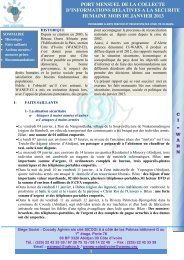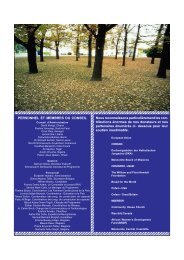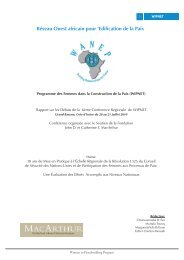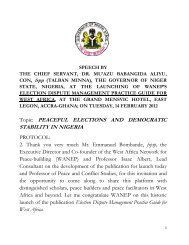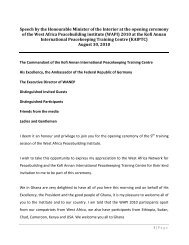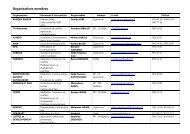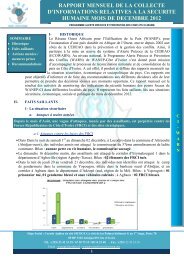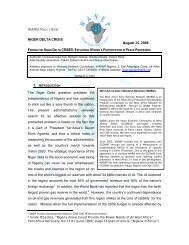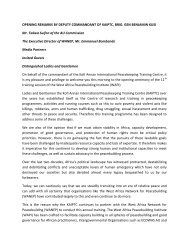DEVELOPMENT AND IMPLEMENTATION of National Action Plans ...
DEVELOPMENT AND IMPLEMENTATION of National Action Plans ...
DEVELOPMENT AND IMPLEMENTATION of National Action Plans ...
You also want an ePaper? Increase the reach of your titles
YUMPU automatically turns print PDFs into web optimized ePapers that Google loves.
Executive SummaryThe suffering <strong>of</strong> women in war, the under-valued and under-utilized conflict preventionand peacebuilding work <strong>of</strong> women and the leadership they show in rebuilding wartornsocieties and their continued exclusion from positions <strong>of</strong> decision-making in thesphere <strong>of</strong> peace and security resulted in many calls for women’s full and equal participationand gender mainstreaming in all peace and security initiatives with the resultant documentUNSCR 1325. As a result, on October 31, 2000, UNSCR 1325 was unanimously adopted. Sincethen four other complementary resolutions have been adopted – UNSCR 1820, 1888, 1889and 1960. These five resolutions are <strong>of</strong>ten referred to as the Women and Peace and SecurityFramework. They provide the basis for advocacy, education, reform and capacity buildingon gender equality and women’s rights as they relate to peace operations.The United Nations Security Council (UNSC) recognized that the national implementation <strong>of</strong>UNSCR 1325 and related resolutions is an important mechanism for furthering the women,peace and security agenda. This was why the United Nations Security Council Presidentialstatements <strong>of</strong> 2004/40 and 2005/52, called to member states to implement the resolution1325 including the development <strong>of</strong> NAPs or other national level strategies such as peacepolicies, gender policies or medium/long term development plans and has consistentlyrecommended that member states accelerate the development <strong>of</strong> both national andregional action plans for the implementation <strong>of</strong> UNSCR 1325.More than a decade after the adoption <strong>of</strong> UNSCR 1325, women’s participation in formalpeace negotiations still remains minimal; women’s specific needs in refugee and IDPscamps and in disarmament and reintegration efforts are still largely un-met; sexual andother forms <strong>of</strong> VAWG is still prevalent during and after armed conflict and the overallprogress on implementing UNSCR 1325 globally has remained slow and inconsistent andonly 42 out <strong>of</strong> the 192 member states have elaborated and adopted NAPs. Lack <strong>of</strong> politicalwill and technical know-how have been cited as some <strong>of</strong> the reasons for the slow pace inelaboration <strong>of</strong> NAPs. The second reason – lack <strong>of</strong> technical know-how is the main reason forthis guideline whose purpose is to provide a generic template – a simple step-by-step guideto the formulation and implementation <strong>of</strong> NAPs.The Guideline is divided into five sections. Section 1 deals with the introduction whichprovides information on women, peace and security, UNSCR 1325 and related resolutions,importance <strong>of</strong> NAPs in the implementation <strong>of</strong> UNSCR 1325 and the purpose <strong>of</strong> the guideline.Section 2 focuses on the processes <strong>of</strong> developing the guideline including the inception,context/situational analysis, stakeholder mapping and their roles, establishment <strong>of</strong> acoordinating mechanism, enabling stakeholder participation, through defining content <strong>of</strong>NAPs, identifying opportunities for resources mobilization, drafting <strong>of</strong> the NAPs, validation,xi



![English [266KB] - West Africa Network for Peacebuilding](https://img.yumpu.com/50460007/1/184x260/english-266kb-west-africa-network-for-peacebuilding.jpg?quality=85)
